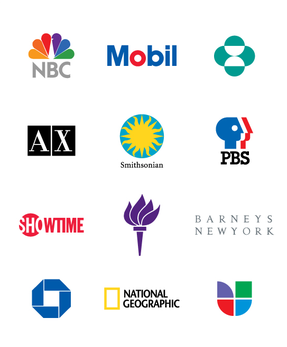Related Research Articles

A logo is a graphic mark, emblem, or symbol used to aid and promote public identification and recognition. It may be of an abstract or figurative design or to include the text of the name that it represents as in a wordmark.
Alan Gerard Fletcher was a British graphic designer. In his obituary, he was described by The Daily Telegraph as "the most highly regarded graphic designer of his generation, and probably one of the most prolific".

Serge Ivan Chermayeff was a Russian-born British architect, industrial designer, writer, and co-founder of several architectural societies, including the American Society of Planners and Architects.

Arthur Samuel Wilbur Chantry II is a graphic designer often associated with the posters and album covers he has done for bands from the Pacific Northwest, such as Mudhoney, Mono Men, Soundgarden, and The Sonics.

Eliot Fette Noyes was an American architect and industrial designer, who worked on projects for IBM, most notably the IBM Selectric typewriter and the IBM Aerospace Research Center in Los Angeles, California. Noyes was also a pioneer in development of comprehensive corporate-wide design programs that integrated design strategy and business strategy. Noyes worked on corporate imagery for IBM, Mobil Oil, Cummins Engine and Westinghouse.

Steven Heller is an American art director, journalist, critic, author, and editor who specializes in topics related to graphic design.

Robert Brownjohn was an American graphic designer known for blending formal graphic design concepts with wit and 1960s pop culture. He is best known for his motion picture title sequences, especially From Russia with Love and Goldfinger.
Institute of Design (ID) at the Illinois Institute of Technology, founded as the New Bauhaus, is a graduate school teaching systemic, human-centered design.

Chermayeff & Geismar & Haviv is a New York-based branding and graphic design firm. It is currently led by partners Tom Geismar and Sagi Haviv.
Jennifer Morla is a graphic designer and professor based in San Francisco. She received the Cooper Hewitt Smithsonian National Design Award in Communication Design in 2017.
Alvin Lustig was an American book designer, graphic designer and typeface designer. Lustig has been honored by the American Institute of Graphic Arts and the Art Directors Club Hall of Fame for his significant contributions to American design.

Peter Chermayeff LLC is a Massachusetts-based architectural firm which specializes in aquarium architecture and exhibit design, from conceptual planning to the details of final realization.

Sagi Haviv is an Israeli-American graphic designer and a partner in the design firm Chermayeff & Geismar & Haviv. Called a "logo prodigy" by The New Yorker, and a "wunderkind" by Out magazine, he is best known for having designed the trademarks and visual identities for brands and institutions such as Discovery, Inc.'s online streaming service Discovery+, the United States Olympic & Paralympic Museum, the US Open tennis tournament, Conservation International, Harvard University Press, and L.A. Reid's Hitco Entertainment, and tech and electric car company Togg.
Geismar is a Thuringian municipality in the district Eichsfeld, in Thuringia, Germany

Lella Vignelli was an Italian architect, designer, and businesswomen. She collaborated closely throughout much of her life with her husband Massimo Vignelli, with whom she founded Vignelli Associates in 1971.
Ruth Ansel is an American graphic designer. She became a co-art director of Harper's Bazaar in the 1960s alongside Bea Feitler. In the 1970s she was art director of The New York Times Magazine and in the 1980s House & Garden, Vanity Fair, and Vogue. She was the first female to hold these positions.

Mackey Saturday is an American designer and typographer whose work includes logos for Instagram, Oculus and Luxe. He runs his own design firm and was formerly a principal at New York City design firm Chermayeff & Geismar & Haviv.
Alexandra Lange is an American architecture and design critic and author based in New York. The author of a series of critically acclaimed books, Lange is the architecture critic for Curbed. She has bylines published in The New Yorker, The New York Times, The Atlantic, Metropolis, Architect magazine, Architectural Digest; Architectural Record, The Architect’s Newspaper, Cite; Domus; Domino; Dwell; GOOD; Icon, The Nation, New York magazine, Places Journal, Print and Slate. Lange is a Loeb Fellow, and her work has been recognized through a number of awards, including the 2019 Steven Heller Prize for Cultural Commentary.
Vignelli Associates was a design firm co-founded and run by Massimo and Lella Vignelli in New York City, from 1971 until 2014. They worked firmly within the modernist tradition, stressing simplicity by using basic geometric shapes and a limited range of typefaces. Their design work, encompassing graphic design, branding and corporate identity, architecture and interiors, and industrial design is considered among the most influential of the 20th century.
References
- ↑ Marquis Who's Who on the Web
- 1 2 3 "Thomas Geismar | Graphic Design Archive | RIT Libraries | RIT". library.rit.edu. Retrieved 2019-06-05.
- ↑ "Chermayeff & Geismar & Haviv". www.cghnyc.com. Retrieved 2019-06-05.
- ↑ Dunne, Carey (2014-08-28). "6 Questions For Tom Geismar, Illustrious Designer Of PBS, Xerox, And Mobil Logos". Fast Company. Retrieved 2019-06-05.
- 1 2 "1979 AIGA Medalist: Ivan Chermayeff and Thomas Geismar". AIGA | the professional association for design. Retrieved 2019-06-05.
- ↑ Clifford, John (2014). Graphic Icons: Visionaries who Shaped Modern Graphic Design. Pearson Education. ISBN 9780321887207.
- ↑ "Tom Geismar". ADC • Global Awards & Club. Retrieved 2019-06-05.
- ↑ "Tom Geismar on The National Design Awards Gallery". ndagallery.cooperhewitt.org. Retrieved 2019-06-05.
- ↑ Mazzoleni, Melissa (2014-09-18). "SVA Masters Recipient: Tom Geismar". Print Magazine. Retrieved 2019-06-06.